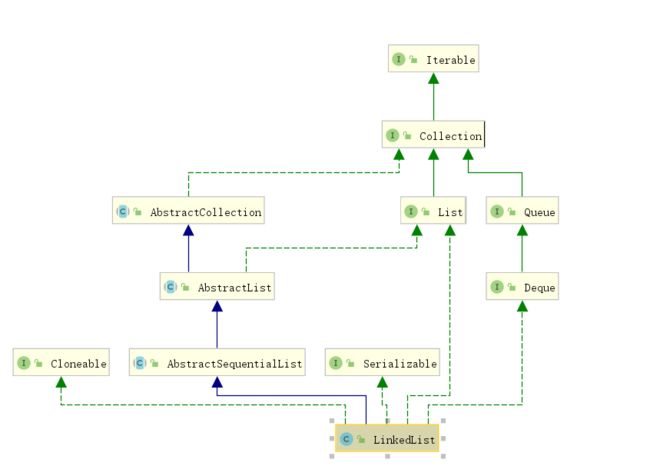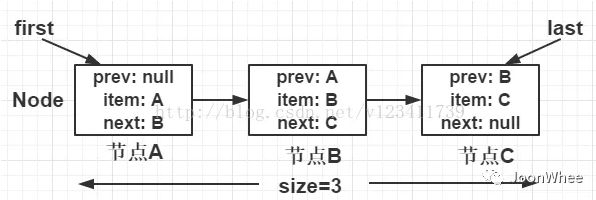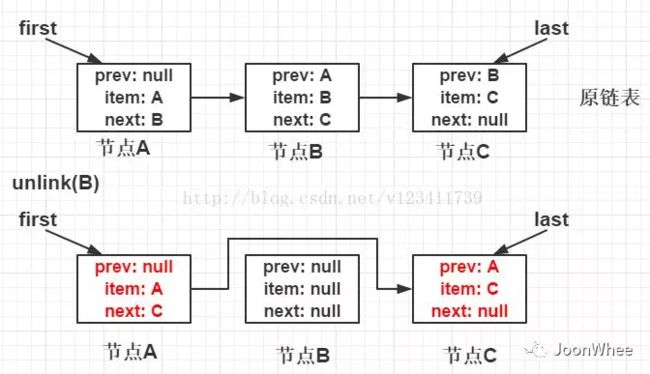【Java进阶之路】LinkedList源码分析
概述
LinkedList也是我们经常使用的集合,本文就LinkedList的几个主要方法展开介绍,并结合几个图片来介绍几个重要操作。
基础属性
transient int size = 0; //节点数量
/**
* Pointer to first node.
* Invariant: (first == null && last == null) ||
* (first.prev == null && first.item != null)
*/
transient Node first; //第一个节点(头节点)
/**
* Pointer to last node.
* Invariant: (first == null && last == null) ||
* (last.next == null && last.item != null)
*/
transient Node last;//最后一个节点(尾节点)
//Node的数据结构
private static class Node {
E item; //存放的对象
Node next; //下一个节点
Node prev; //上一个节点
Node(Node prev, E element, Node next) {
this.item = element;
this.next = next;
this.prev = prev;
}
}
基本数据结构图如下:
add方法
public boolean add(E e) {
//调用linkLast方法,将节点添加到尾部
linkLast(e);
return true;
}
//在index位置插入节点, 节点值为element
public void add(int index, E element) {
//校验index是否越界
checkPositionIndex(index);
//如果索引为size,即将element插 入链表尾部
if (index == size)
//调用linkLast将节点插入链表尾部
linkLast(element);
//否则,将element插入原index位置节点的前面,
//即:将element插入index位置,将原index位置节点移到index+1的位置
else
//调用linkBefore插入index位置
linkBefore(element, node(index));
}
add(E e):调用linkLast方法将元素添加到尾部(linkLast方法详解见下文)
add(int index, E element):
- 检查index是否越界
- 比较index与size,如果index==size,则代表插入位置为链表尾部,调用linkLast方法(linkLast方法详解见下文),否则调用linkBefore方法(LinkBefore方法详解见下文)
get方法
public E get(int index) {
//校验index是否越界
checkElementIndex(index);
//根据index,调用node方法寻找目标节点,寻找目标节点的item
return node(index).item;
}
根据index,调用node方法(见下文node方法详解)寻找目标节点,返回目标节点的item。
node方法
//根据index位置寻找node
Node node(int index) {
//如果index < size/2, 则代表index在链表的前半部分,从头结点开始遍历
if (index < (size >> 1)) {
Node x = first;
//从first节点遍历,直到index位置
for (int i = 0; i < index; i++)
x = x.next;
return x;
//否则,index在链表的后半部分,从尾节点开始遍历
} else {
Node x = last;
//从last节 点遍历,直到index位 置
for (int i = size - 1; i > index; i--)
x = x.prev;
return x;
}
}
如果index在链表的前半部,则从头节点开始遍历;否则从尾节点开始遍历。
set方法
//替换index位置节点的值为element
public E set(int index, E element) {
//检查index是否越界
checkElementIndex(index);
//根据index, 调用node方法寻找到目标节点
Node x = node(index);
//节点的原值
E oldVal = x.item;
//将节点的item属性替换为element
x.item = element;
//返回节点原值
return oldVal;
}
检查index是否越界
调用node方法寻找目标节点(见上文node方法详解)
将目标节点的item属性设为element
remove方法
public boolean remove(Object o) {
//如果o为空,则遍历链表寻找item属性为空的节点
if (o == null) {
for (Node x = first; x != null; x = x.next) {
//如果目标节点存在
if (x.item == null) {
//则调用unlink方法将该节点移除
unlink(x);
return true;
}
}
//如果o不为空, 则遍历链表寻找item属性跟o相同的节点
} else {
for (Node x = first; x != null; x = x.next) {
//如果目标节点存在
if (o.equals(x.item)) {
//则调用unlink方法将该节点移除
unlink(x);
return true;
}
}
}
return false;
}
//移除index位置的节点
public E remove(int index) {
//检查index是否越界
checkElementIndex(index);
//移除index位置的节点
return unlink(node(index));
}
remove(Object o):
- 判断o是否为null,如果o为null,则遍历链表寻找item属性为空的节点,并调用unlink方法将该节点移除(unlink方法详解见下文)
- 如果o不为null, 则遍历链表寻找item属性跟o相同的节点,并调用unlink方法将该节点移除(unlink方法详解见下文)
remove(int index):
- 检查index是否越界
- 调用unlink方法,移除index位置的节点(unlink方法详解见下文)
clear方法
//清除链表的所有节点
public void clear() {
// Clearing all of the links between nodes is "unnecessary", but:
// - helps a generational GC if the discarded nodes inhabit
// more than one generation
// - is sure to free memory even if there is a reachable Iterator
//从头节点开始遍历,将所有节点的属性清空
for (Node x = first; x != null; ) {
Node next = x.next;
x.item = null;
x.next = null;
x.prev = null;
x = next;
}
//将头节点和尾节点设置为null
first = last = null;
//size清零
size = 0;
modCount++;
}
从first节点开始,遍历将所有节点的属性清空
将first节点和last节点设为null
linkLast方法
//将e放到链表的最后一个节点
void linkLast(E e) {
//拿到当前的尾节点l节点
final Node l = last;
//使用e创建一个新的节点newNode, prev属性为l节点,next 属性为null
final Node newNode = new Node<>(l, e, null);
//将当前尾节点设置为上面新创建的节点newNode
last = newNode;
//如果l节点为空则代表当前链表为空,将newNode设置为头结点
if (l == null)
first = newNode;
//否则将l节点的next属性设置为newtNode
else
l.next = newNode;
size++;
modCount++;
}
- 拿到当前的尾节点 l 节点
- 使用e创建一个新的节点newNode,prev属性为l节点,next属性为null
- 将当前尾节点设置为上面新创建的节点newNode
- 如果l节点为空则代表当前链表为空, 将newNode设置为头结点,否则将l节点的next属性设置为newNode
过程如图所示
linkBefore方法
// 将节点e插入节点succ前面
void linkBefore(E e, Node succ) {
// assert succ != null;
//拿到succ节点的prev节点,赋值给pred节点
final Node pred = succ.prev;
//使用e创建一个新的节点newNode, 其中prev属性为pred节点,next属性为succ节点
final Node newNode = new Node<>(pred, e, succ);
//将succ 节点的prev属性设置为newNode
succ.prev = newNode;
//如果pred节点为null,则代表succ 节点为头结点,
//要把e插入succ前面,只 需将first设置为newNode
if (pred == null)
first = newNode;
//否则将pred节点的next属性设为newNode
else
pred.next = newNode;
size++;
modCount++;
}
- 拿到succ节点的prev节点
- 使用e创建一个新的节点newNode,其中prev属性为pred节点,next属性为succ节点
- 将succ节点的prev属性设置为newNode
- 如果pred节点为null,则代表succ节点为头结点,要把e插入succ前面,因此将first设置为newNode,否则将pred节点的next属性设为newNode
过程如图所示
unlink方法
//移除链表上的x节点
E unlink(Node x) {
// x节点的值
final E element = x.item;
// x节点的下一个节点next节点
final Node next = x.next;
// x节点的上一个节点prev节点
final Node prev = x.prev;
//如果prev为空, 则代表x节点为头结点,则将first指向next即可
if (prev == null) {
first = next;
//否则,x节点不为头结点,
} else {
//将prev节点的next属性指向x节点的next属性
prev.next = next;
//将x的prev属性清空
x.prev = null;
}
如果next为空,则代表x节点为尾节点,则将last指向prev即可
if (next == null) {
last = prev;
//否则,节点不为尾节点
} else {
//将next节点的prev属性指向x节点的prev属性
next.prev = prev;
//将x的next属性清空
x.next = null;
}
//将x的值清空,以便垃圾收集器回收x对象
x.item = null;
size--;
modCount++;
return element;
}
- 定义element为x节点的值,next为x节点的下一个节点,prev为x节点的上一个节点
- 如果prev为空,则代表x节点为头结点,则将first指向next即可;否则,x节点不为头结点,将prev节点的next属性指向x节点的next属性,并将x的prev属性清空
- 如果next为空,则代表x节点为尾节点,则将last指向prev即可;否则,x节点不为尾节点,将next节点的prev属性指向x节点的prev属性,并将x的next属性清空
- 将x的item属性清空,以便垃圾收集器回收x对象
过程如图所示
来自:LinkedList详解




